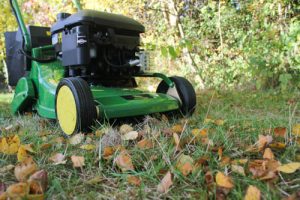Collecting leaves – the perfect job for a bright, sunny day.
As the nights draw in, it is time to wrap up your pots and plants to protect them from frost and cold. Terracotta or glazed pots should be wrapped with several layers of ‘bubble wrap’ or hessian and raised from the ground on bricks or pot feet, to prevent water-logging and cracking. Containerised plants can also be over-wintered in a frost-free glasshouse or shed, at the base of a sheltered wall, under an evergreen hedge and covered with leaves, under evergreen trees, wherever you can find room. Move ‘Acer’s’ in containers to a place where they are protected from frost and cold winds. Make a tripod of canes over borderline hardiness shrubs, cover them with horticultural fleece, plant covers or cloches and bind the leaves of ‘Cordyline’ together, tying them in place with twine.

It is important to keep your lawn leaf free or grass weakens and turns yellow. The easiest way to do this is with a rotary mower, on a dry day; chopping the leaves and mixing them with lawn clippings further increases the nutrient value, turning them into valuable humus rich soil conditioner.
If you prefer to rake, collect the leaves on a still day, when they are dry. On windy days, rake in the direction that the wind is blowing and gather them with leaf boards or use a lawn vacuum. Leaf boards, made of plywood, enable large volumes to be picked up effectively. Put small volumes into a bin liner, moisten them to help them rot, then pierce holes in the bag with a garden fork, tie the top loosely, then stack them together, checking the contents from time to time to ensure they are still moist. Alternatively, make a large frame from chicken wire, supported at the corners or at intervals around the circle with stakes or bamboo canes. Thick leaves like walnut and evergreens like holly, Spotted and Cherry laurel, are better shredded and added to the compost heap. Composted pine needles produce acidic organic matter that is ideal for mulching ericaceous plants, like camellia’s and blueberries. However, they break down very slowly, taking up to three years to decay into nature’s gold.
Most leaf mould takes about two years, to rot. Anything less than two years old can be used as mulch, soil improver, autumn top-dressing for lawns and a winter covering for bare soil. Sieved compost over two years old is perfect in seed sowing mixes or mixed equally with sharp sand, garden compost and loam for use as potting compost, as the Victorian’s did.
It is also a good time to plant roses, providing the soil is not waterlogged or frozen and to prune back cluster flowered or ‘hybrid Tea’ roses by on third, particularly on windy sites, to prevent ‘wind rock’. Climbers can be pruned by removing dead, diseased dying, crossing rubbing or weak branches, tying new shoots into the gaps and cutting back side shoots that have flowered by two thirds and old stems back to the base to encourage new growth. It is also an ideal time to plant conifer’s, too, so there are plenty to keep you busy and warm.
Happy Gardening! Matt


